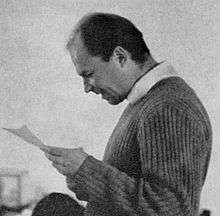Piotr Słonimski
| Piotr Słonimski | |
|---|---|
 Piotr Słominski | |
| Born |
November 9, 1922 Warsaw, Poland |
| Died |
April 25, 2009 (aged 86) Paris, France |
| Nationality | French |
| Fields | Genetics |
| Known for | Work on mitochondrial genetics |
Piotr Słonimski (born November 9, 1922 in Warsaw, died April 25, 2009 in Paris) – Polish-born French geneticist, pioneer of yeast mitochondrial genetics, nephew of the Polish poet Antoni Słonimski.
Biography
Słonimski was born in Warsaw in 1922 and he finished "underground" studies of medicine during World War II in occupied Poland. He was a member of the Polish resistance movement and the Armia Krajowa, and he fought during the Warsaw Uprising. According to his own account,[1] he became interested with genetics when he discovered, among ruins of a German police station and while performing an act of sabotage, a German book on the experiments of George Wells Beadle and Boris Ephrussi.

After the war, he finished medical studies at the Jagiellonian University in Kraków. In 1947, Słonimski emigrated and settled in France, as members of Armia Krajowa were prosecuted by the newly established communist government in Poland. Once in Paris, he joined the group of Boris Ephrussi and started working in the field of genetics. In 1952 he obtained his Ph. D.
Between 1971 and 1991, Słonimski was the director of Centre de Génétique Moléculaire of the French CNRS in Gif-sur-Yvette.
Słonimski never broke the contacts with his home country, Poland. Since 1980, he was heading the Solidarité France-Pologne, organizing aid for Poland.[2] He frequently hosted Polish intelectualists and dissidents, such as Adam Michnik, Tadeusz Mazowiecki, Maria and Leszek Kołakowski. When martial law was introduced in Poland in 1981, he organized financial support for scientists repressed by the government.[3] The money was smuggled and distributed in Poland by two Polish couriers: Wacław Gajewski, a professor of genetics, and Władysław Kunicki-Goldfinger, a professor of microbiology.[3] Słonimski gave them the code names "Eukaryote" and "Prokaryote", as Gajewski was working on fungi, and Kunicki-Goldfinger was a microbiologist.
Scientific achievements
Piotr Słonimski did pioneering work on yeast mitochondrial genetics.[1] He was one of the first to show that genetic information is passed outside of the nucleus in mitochondria,[4] and his subsequent, much cited work led to establishment of the field of mitochondrial genomics. In 1980, he discovered that some parts of the introns in yeast mitochondrial encode an enzyme—which he called maturase—that aids the splicing and the maturation of mRNA.[5]
Awards
- CNRS Gold medal received in 1985
- Commander's Cross with Star Order of Polonia Restituta, one of the highest Polish Orders (2009)
- Doctor honoris causa of the universities in Louvain-la-Neuve, Warsaw and Wrocław
References
- 1 2 "In Memoriam Piotr Slonimski (1922–2009) The Unconventional Yeast Geneticist". Genetics. 183: 1–2. 2009. doi:10.1534/genetics.109.106930.
- ↑ Zagórski, Sławomir (2009). "Piotr Słonimski". Gazeta Wyborcza.
- 1 2 Węgleński, Piotr. "Profesor Wacław Gajewski".
- ↑ Słonimski, Piotr (1953). La formation des enzynies respiratoires chez la levure. Paris: Masson et Cie.
- ↑ Lazowska, J.; Jacq, C.; Slonimski, P.P. (1980). "Sequence of introns and flanking exons in wild-type and box3 mutants of cytochrome b reveals an interlaced splicing protein coded by an intron". Cell. Elsevier. 22 (2): 333–348. doi:10.1016/0092-8674(80)90344-X. PMID 7004642.